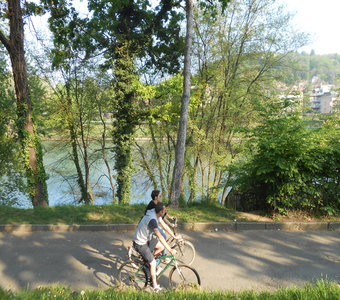VenTo seeks second Expo gear

TURIN-“I like to think of VenTo as the string of a necklace” says Paolo Pileri, the tireless promoter of the scheme that is seeking to construct an unbroken cycle path along the river Po from Turin to Venice. “The pearls are the towns it passes through along the way.”
The project professor Plileri and his colleagues at Milan Polytechnic have devised is an ambitious one. It aims to create an unbroken 684 km stretch of road exclusively for cyclists, complete with bridges and junctions. The road will provide a safe environment for families to cycle along together without having to worry about cars or potholes. At present there are only 100km of cycle path that are already fit for the project. A further 284 require only small adjustments. This leaves 300km left to be built, an undertaking which is not straightforward.
“The problem is not money” says Pileri who explains that the costs of constructing the remaining 300 km would amount to a modest 7 million euros a year for each region along the pathway. In addition to this, the European Union is set to make available six billion euros over the next six years to finance sustainable projects like VenTo. The total cost of completing the Vento project comes in at 80 million euros. Put into context, this amounts to the cost of building 2km of motorway. Although, 300 km of cycle path would bring significant benefits to the economy with much less environmental impact. “The biggest obstacles are cultural” reckons Pileri, “we need to get regions working together that are used to working separately.”
The project has so far met resistance from institutions such as groups responsible for maintenance along the banks of the Po, who are concerned about the impact of the heavy traffic the project could bring to the banks of the Po. Pileri remains defiant: “This project is not just about cyclists, it concerns everybody, and resistance is melting as people see that the benefits of the projects are for everybody.”
The benefits could be substantial. The project claims that it will bring 100 million euros a year to the local economies and create 2000 new jobs along the cycle route, bringing 300-400 thousand tourists to Italy a year. Claudio Pedroni of FIAB, the organization which is responsible for managing cycle paths in Italy, is a little skeptical of such large figures:
“I know the amount of money coming in from Danube cycle route is a bit more than 60 million a year, so I think that 100 Million from VenTo is a bit optimistic, but we believe that the impact to local economies along the Po corridor will be very, very important.” Pileri, meanwhile, maintains that the Vento project can outperform similar European cycle routes in north and central Europe as Italy's Mediterranean climate will allow cyclists to enjoy a longer season of favorable weather.
Whatever figures you believe the important thing however is that the impact to the local economies is significant. In one scene from the documentary “VenTo Italy by bike along the River Po,” a project made last year to promote VenTo, a German cyclist is stopped and asked “How many cyclists have you seen each day?” his response, “Five a day, if your lucky!.” A very low figure, especially when it is estimated that in Germany, cycle tourism is worth 4 billion euros a year. Even a tiny fraction of such a figure would be very welcome for the towns along the VenTo pathway which have been in decline for years and offer few possibilities for young people looking for work.
The future looks bright for the Vento project. Italy has seen a huge surge in interest in bicycles over the past few years, and bicycles have started outselling cars consistently. In addition to this, many cities have adopted bike sharing schemes and there is currently new pro bicycle legislation working its way through parliament. Successive culture and tourism ministers, Massimo Bray and Dario Franceschini have thrown their support behind the VenTo project. Which is all very well, but little has materialized in terms of new paths built.
Pileri admits that the initial two years stated for the project’s completion looks like it will need to be amended to at least three as the project fights with bureaucracy and cultural resistance in a country not renowned for completing large scale engineering projects on time.
Can the project complete its first stage in time for the Expo in Milan next year? It looks doubtful; “I think the government would like that” says Pileri, “let's wait and see.”



